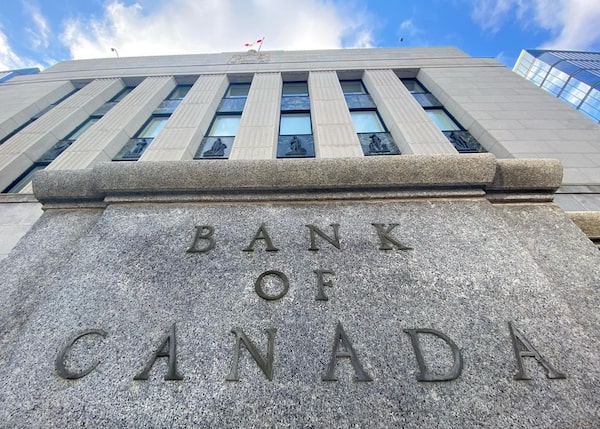
The Bank of Canada building is seen in Ottawa in April, 2020. The central bank’s current five-year inflation-control agreement with the federal government expires at the end of 2021.The Canadian Press
For almost three decades, the Bank of Canada has conducted monetary policy with the singular goal of keeping inflation low and stable. But that may soon change.
The long-standing consensus surrounding the bank’s inflation-targeting mandate appears to be eroding as the current crisis pushes debt skyward. There are signs the bank is considering a relaxation of its strict 2-per-cent annual inflation target as one way of helping governments and businesses deal with the massive borrowing they have undertaken to get through the coronavirus pandemic.
The Bank of Canada this week undertook public consultations “to gather Canadians’ views on the bank’s approach to monetary policy.” Under a campaign dubbed “Let’s Talk Inflation,” the bank is asking the public to weigh in on whether it should abandon its 2-per-cent inflation target in favour of approaches that focus on other objectives, such as maximizing employment or economic output.
Canada’s central bank is not alone in rethinking its mandate. The U.S. Federal Reserve is believed to be preparing for a move away from a strict inflation target to what is known as price-level targeting, or PLT. Under this approach, the Fed would allow inflation to overshoot the 2-per-cent target in coming years to make up for recent years of below-target price increases.
Fed chairman Jerome Powell is expected to provide an update on the U.S. central bank’s policy framework at this week’s annual Jackson Hole symposium, which is being held virtually as a result of the pandemic. The practical effect of a move to PLT would be to send a signal to markets that the Fed would not raise interest rates even if inflation rises above 2 per cent.
Bank of Canada Governor Tiff Macklem will address the Jackson Hole participants right after Mr. Powell on Thursday. But unlike the Fed, Canada’s central bank is only at the beginning of a year-long review of its own mandate.
The central bank’s current five-year inflation-control agreement with the federal government expires at the end of 2021. Part of its review is this week’s invitation to Canadians to share their views on alternative approaches to monetary policy. These include PLT, as well as a variation known as nominal gross domestic product targeting. Under the latter, the bank says, “when the economy is not doing well, we would let inflation rise to whatever is needed to maintain overall spending.”
Yet another option would involve the bank’s adoption of a dual mandate to target inflation and maximum sustainable employment levels. Under this approach, the bank would “occasionally accept higher inflation to benefit from higher employment.”
Bank of Canada calls for broader input on updated inflation-target framework
U.S. just crossed the line debt hawks have warned about for decades
The Bank of Canada first adopted its inflation-control mandate in a 1991 arrangement with the federal government that has been renewed at five-year intervals ever since. The last time, in 2016, the bank concluded there was a “very compelling” case for sticking with its 2-per-cent inflation target, and then-federal finance minister Bill Morneau agreed.
“The bar for change is high, and, based on the evidence, we see no strong justification to alter the framework at this time,” then-Bank of Canada governor Stephen Poloz said in a letter to Mr. Morneau at the time.
In a 2018 speech, senior deputy governor Carolyn Wilkins further explained that the bank considered raising the inflation target to 4 per cent in 2016 as exceptionally low interest rates had left it with limited firepower to deal with a future downtown. By letting inflation and nominal interest rates rise in sync, the argument went, the bank would have greater flexibility to revive the economy during a future downturn by cutting rates.
Bank researchers found, however, that “higher inflation would be felt by everyone, and most acutely by people living on fixed or lower incomes. Moreover, we were concerned that the bank’s credibility would be undermined if people thought it was a slippery slope to even higher [inflation] targets down the road,” Ms. Wilkins said then.
The push for a reconsideration of 2-per-cent inflation target appears to be gaining ground, however. The central bank has resorted to quantitative easing for the first time, during the pandemic, making large-scale purchases of government bonds. The bank’s online questionnaire says these actions “help to make sure the financial system works properly and to increase spending in the economy.” While the survey asks Canadians if they support QE, it does not elaborate on the longer-term consequences of a policy that effectively amounts to printing vast sums of money to backstop federal spending.
The consumer price index nosedived earlier this year as the pandemic struck and deflation remains a greater near-term risk for the bank than the prospect of runaway inflation. As a result, the real impact of an abandonment of the 2-per-cent inflation target would only be felt as the recovery gains steam.
Moderately higher inflation rates in the future would make it easier for borrowers to pay down debts accumulated during the crisis. Assuming wages and taxes rise in line with inflation, repaying previously incurred debts would be less onerous for governments and private borrowers alike.
What that would mean for the Canadian dollar, investment decisions and the purchasing power of average Canadians is another matter altogether. That’s where the slippery slope comes in. The bank will need to tread carefully lest it lose its footing altogether.
Your time is valuable. Have the Top Business Headlines newsletter conveniently delivered to your inbox in the morning or evening. Sign up today.